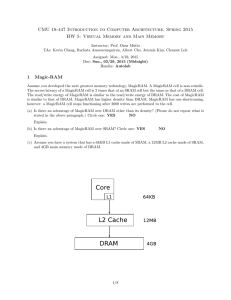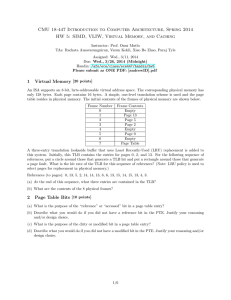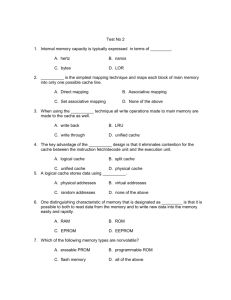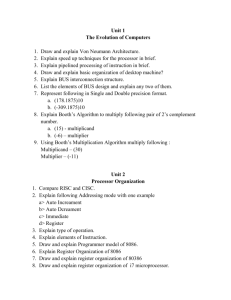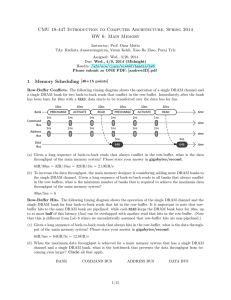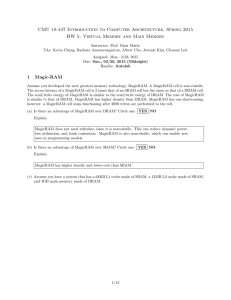CMU 18-447 Introduction to Computer Architecture, Spring 2014
advertisement
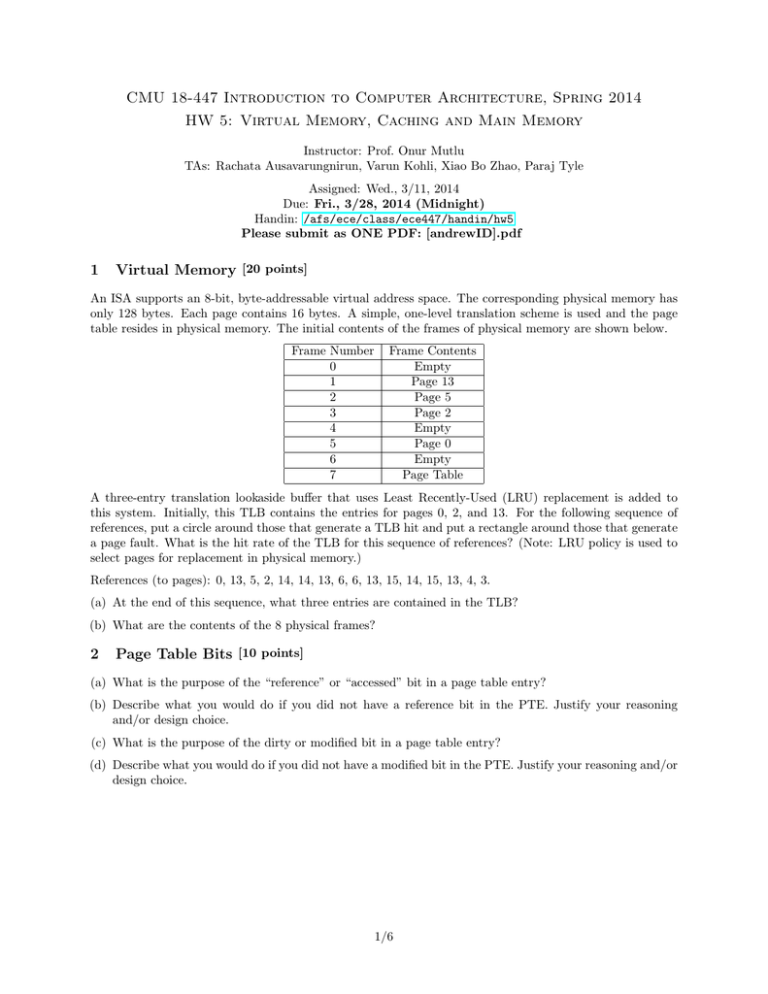
CMU 18-447 Introduction to Computer Architecture, Spring 2014 HW 5: Virtual Memory, Caching and Main Memory Instructor: Prof. Onur Mutlu TAs: Rachata Ausavarungnirun, Varun Kohli, Xiao Bo Zhao, Paraj Tyle Assigned: Wed., 3/11, 2014 Due: Fri., 3/28, 2014 (Midnight) Handin: /afs/ece/class/ece447/handin/hw5 Please submit as ONE PDF: [andrewID].pdf 1 Virtual Memory [20 points] An ISA supports an 8-bit, byte-addressable virtual address space. The corresponding physical memory has only 128 bytes. Each page contains 16 bytes. A simple, one-level translation scheme is used and the page table resides in physical memory. The initial contents of the frames of physical memory are shown below. Frame Number 0 1 2 3 4 5 6 7 Frame Contents Empty Page 13 Page 5 Page 2 Empty Page 0 Empty Page Table A three-entry translation lookaside buffer that uses Least Recently-Used (LRU) replacement is added to this system. Initially, this TLB contains the entries for pages 0, 2, and 13. For the following sequence of references, put a circle around those that generate a TLB hit and put a rectangle around those that generate a page fault. What is the hit rate of the TLB for this sequence of references? (Note: LRU policy is used to select pages for replacement in physical memory.) References (to pages): 0, 13, 5, 2, 14, 14, 13, 6, 6, 13, 15, 14, 15, 13, 4, 3. (a) At the end of this sequence, what three entries are contained in the TLB? (b) What are the contents of the 8 physical frames? 2 Page Table Bits [10 points] (a) What is the purpose of the “reference” or “accessed” bit in a page table entry? (b) Describe what you would do if you did not have a reference bit in the PTE. Justify your reasoning and/or design choice. (c) What is the purpose of the dirty or modified bit in a page table entry? (d) Describe what you would do if you did not have a modified bit in the PTE. Justify your reasoning and/or design choice. 1/6 3 Caching [15 points] Below, we have given you four different sequences of addresses generated by a program running on a processor with a data cache. Cache hit ratio for each sequence is also shown below. Assuming that the cache is initially empty at the beginning of each sequence, find out the following parameters of the processor’s data cache: • Associativity (1, 2 or 4 ways) • Block size (1, 2, 4, 8, 16, or 32 bytes) • Total cache size (256 B, or 512 B) • Replacement policy (LRU or FIFO) Assumptions: all memory accesses are one byte accesses. All addresses are byte addresses. Sequence No. 1 2 3 4 4 Address Sequence 0, 2, 4, 8, 16, 32 0, 512, 1024, 1536, 2048, 1536, 1024, 512, 0 0, 64, 128, 256, 512, 256, 128, 64, 0 0, 512, 1024, 0, 1536, 0, 2048, 512 Hit Ratio 0.33 0.33 0.33 0.25 Magic-RAM [25 points] Assume you developed the next greatest memory technology, MagicRAM. A MagicRAM cell is non-volatile. The access latency of a MagicRAM cell is 2 times that of an SRAM cell but the same as that of a DRAM cell. The read/write energy of MagicRAM is similar to the read/write energy of DRAM. The cost of MagicRAM is similar to that of DRAM. MagicRAM has higher density than DRAM. MagicRAM has one shortcoming, however: a MagicRAM cell stops functioning after 2000 writes are performed to the cell. (a) Is there an advantage of MagicRAM over DRAM other than its density? (Please do not repeat what is stated in the above paragraph.) Circle one: YES NO Explain. (b) Is there an advantage of MagicRAM over SRAM? Circle one: YES NO Explain. (c) Assume you have a system that has a 64KB L1 cache made of SRAM, a 12MB L2 cache made of SRAM, and 4GB main memory made of DRAM. 2/6 Assume you have complete design freedom and add structures to overcome the shortcoming of MagicRAM. You will be able to propose a way to reduce/overcome the shortcoming of MagicRAM (note that you can design the hierarchy in any way you like, but cannot change MagicRAM itself). Does it makes sense to add MagicRAM anywhere in this memory hierarchy given that you can potentially reduce its shortcoming? Circle one: YES NO If so, where would you place MagicRAM? Depict in the figure above clearly and describe why you made this choice. If not, why not? Explain below clearly and methodically. (d) Propose a way to reduce/overcome the shortcoming of MagicRAM by modifying the given memory hierarchy. Be clear in your explanations and illustrate with drawings to aid understanding. Explanation: 3/6 5 Memory Scheduling (Optional) Row-Buffer Conflicts. The following timing diagram shows the operation of a single DRAM channel and a single DRAM bank for two back-to-back reads that conflict in the row-buffer. Immediately after the bank has been busy for 10ns with a READ, data starts to be transferred over the data bus for 5ns. 10ns Bank 10ns PRECHARGE 10ns 10ns ACTIVATE READ 10ns PRECHARGE 10ns ACTIVATE READ 1ns 1ns 1ns 1ns 1ns 1ns 1ns 1ns 1ns 1ns 1ns 1ns time Command Bus time Address Bus time Data Bus 5ns 5ns 64B 64B time (a) Given a long sequence of back-to-back reads that always conflict in the row-buffer, what is the data throughput of the main memory system? Please state your answer in gigabytes/second. (b) To increase the data throughput, the main memory designer is considering adding more DRAM banks to the single DRAM channel. Given a long sequence of back-to-back reads to all banks that always conflict in the row-buffers, what is the minimum number of banks that is required to achieve the maximum data throughput of the main memory system? Row-Buffer Hits. The following timing diagram shows the operation of the single DRAM channel and the single DRAM bank for four back-to-back reads that hit in the row-buffer. It is important to note that rowbuffer hits to the same DRAM bank are pipelined: while each READ keeps the DRAM bank busy for 10ns, up to at most half of this latency (5ns) can be overlapped with another read that hits in the row-buffer. (Note that this is different from Lab 6 where we unrealistically assumed that row-buffer hits are non-pipelined.) READ READ Bank time READ 1ns 1ns READ 1ns 1ns Command Bus time 1ns 1ns 1ns 1ns Address Bus Data Bus time 5ns 5ns 5ns 5ns 64B 64B 64B 64B time (c) Given a long sequence of back-to-back reads that always hits in the row-buffer, what is the data throughput of the main memory system? Please state your answer in gigabytes/second. (d) When the maximum data throughput is achieved for a main memory system that has a single DRAM channel and a single DRAM bank, what is the bottleneck that prevents the data throughput from becoming even larger? Circle all that apply. BANK COMMAND BUS ADDRESS BUS DATA BUS Memory Scheduling Policies. The diagram below shows the memory controller’s request queue at time 0. The shaded rectangles are read requests generated by thread T 0, whereas the unshaded rectangles are read requests generated by thread T 1. Within each rectangle, there is a pair of numbers that denotes the request’s (BankAddress, RowAddress). Assume that the memory system has a single DRAM channel and four DRAM banks. Further assume the following. 4/6 • All the row-buffers are closed at time 0. • Both threads start to stall at time 0 because of memory. • A thread continues to stall until it receives the data for all of its requests. • Neither thread generates more requests. (0,0) (3,0) (2,4) (1,9) (0,7) (0,0) (0,0) Youngest (0,0) Oldest For extra credits (15 points), please make sure that you model contention in the banks as well as in all of the buses (address/command/data). (e) For the FCFS scheduling policy, calculate the memory stall time of T 0 and T 1. (f) For the FR-FCFS scheduling policy, calculate the memory stall time of T 0 and T 1. (g) For the PAR-BS scheduling policy, calculate the memory stall time of T 0 and T 1. Assume that all eight requests are included in the same batch. 6 Cache Enigma [35 points] A processor has a 4-way set-associative L1 cache that can house 4 blocks in total. The access latency to this cache is 1 cycle. The replacement policy is true LRU. The processor is known to not employ any prefetching mechanism. The processor also has a 16-way set-associative L2 cache that can house 128 blocks in total. The access latency to this cache is 20 cycles. A programmer writes a test program that in a loop repeatedly accesses only the following data cache blocks (assume billions of iterations are run): A, B, C, D, E, F where A, . . ., F are different cache block addresses. In the steady state (i.e., after the loop has executed for a few iterations), the programmer finds out that the average memory access time is 1 cycle. Then, the programmer writes another program that in a loop repeatedly accesses only the following data cache blocks: A, B, C, D, E, F, G, H In the steady state (i.e., after the loop has executed for a few iterations), the programmer finds out that the average memory access time is 20 cycles. (a) What can you say about this processor? (I.e., what is going on?) Please describe everything you can say, concretely, but be concise. (b) Based on the above information, what do you expect the average memory access time of yet another program that in a loop repeatedly accesses only the following data cache blocks? A, B, C, D, E Explain: (c) Again, based on the above information, what do you expect the average memory access time of yet another program that in a loop repeatedly accesses only the following data cache blocks? 5/6 A, B, C, D, E, F, G Explain: (d) Finally, again, based on the above information, what do you expect the average memory access time of yet another program that in a loop repeatedly accesses only the following data cache blocks? A, B, C, D, E, F, G, H, I Explain: 7 Cache and Virtual Memory [40 points] A four-way set-associative writeback cache has a 211 · 89-bit tag store. The cache uses a custom replacement policy that requires 9 bits per set. The cache block size is 64 bytes. The cache is virtually-indexed and physically-tagged. Data from a given physical address can be present in up to eight different sets in the cache. The system uses hierarchical page tables with two levels. Each level of the page table contains 1024 entries. A page table may be larger or smaller than one page. The TLB contains 64 entries. (a) How many bits of the virtual address are used to choose a set in the cache? (b) What is the size of the cache data store? (c) How many bits in the Physical Frame Number must overlap with the set index bits in the virtual address? (d) On the following blank figure representing a virtual address, draw in bitfields and label bit positions for “cache block offset” and “set number.” Be complete, showing the beginning and ending bits of each field. Virtual Address: (e) On the following blank figure representing a physical address, draw in bitfields and label bit positions for “physical frame number” and “page offset.” Be complete, showing the beginning and ending bits of each field. Physical Address: (f) What is the page size? (g) What is the size of the virtual address space? (h) What is the size of the physical address space? 6/6
